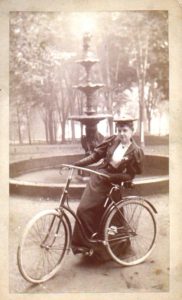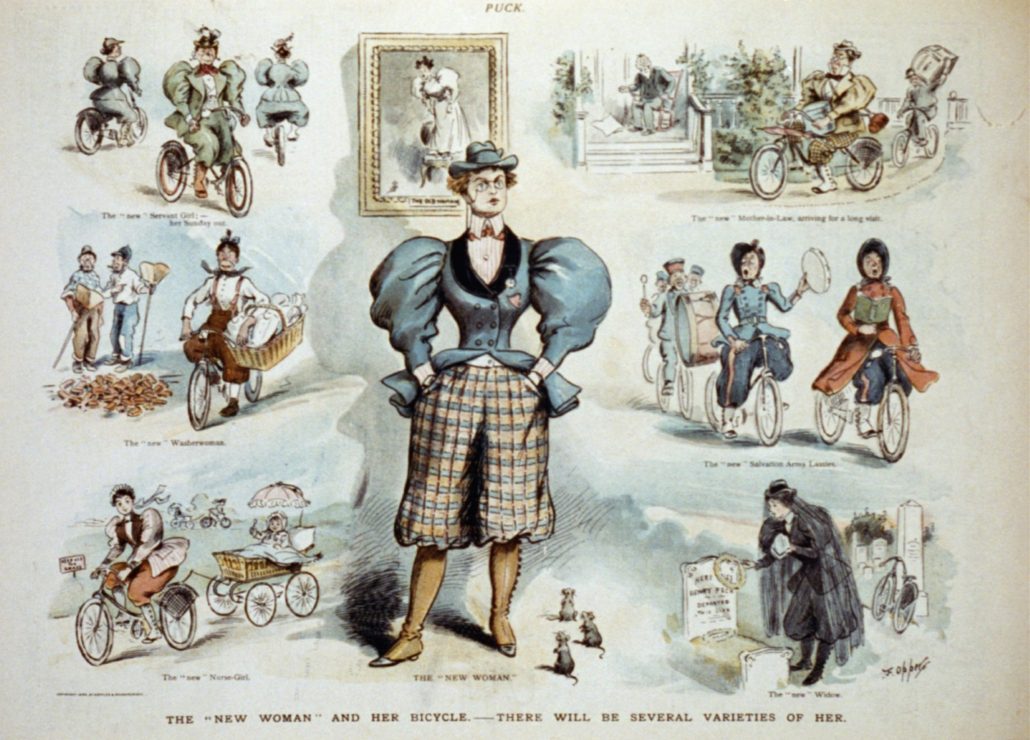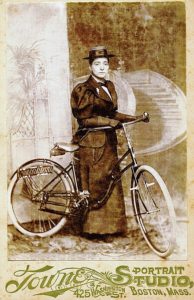March 11, 1897: CODE OF BELL SIGNALS
The Johnstown Daily Republican, March 11, 1897, Fulton County, NY
“Every spring,” says a cyclist, “There is talk of establishing a uniform code of bell signals for the prevention of cycle accidents, and the usual complicated verbal suggestions may be looked for soon. Possibly a code of two signals only, one bell signifying an agreement to turn to the right and two bells to the left, might be practically useful, but it is doubtful. Even the simplest code would probably cause confusion rather than convenience. It is the rule of the road to turn to the right anyway, and it is only rarely that turning to the left is admissible. A signal code would imply the right of the wheelman to turn in either direction, provided the rider approaching from the opposite direction agreed. The less elasticity given to any recognized rule of the road the better.”
Source: NYS Historic Newspapers

Woman with bicycle, 1890s
By 1897, bicycles had been out for more than 50 years, but in the 1880s-1890s, there was a global “Bicycle Craze” where bicycles were more accessible to many with more and more women riding bicycles whether out of necessity or leisure. The popularity of bicycles for women had its controversy from many angles including proper attire and whether it was socially acceptable for women to ride bicycles at all. In May 1897, a newspaper published general sewing patterns for women to follow to create a riding outfit to meet their needs. These new fashions that allowed for greater mobility had mixed reviews. On the one hand, women’s clothing of the day was too restrictive to accommodate bicycle riding activities, but on the other, many harshly criticized the changes needed for women to ride.

The “new woman” and her bicycle – there will be several varieties of her (1895) – F. Opper.
WOMEN BICYCLE RIDERS
In Washington, D.C., there is a society called “The Women’s Rescue League,” and just now it is making war upon the bicycle as a means of rapid transit or pleasure for women. The league proclaims “immorality is alarmingly on the increase among American women,” and all because of the horrid bicycle. It may be that the ladies of the Rescue League are actuated by the loftiest and most sincere motives, but for all that it is unfortunate for themselves that they have so little confidence in their sex. It may be, too, that the rescuers are in a measure right when they say that the bicycle promoted immorality, but a mere assertion that it is so does not make it so.

Annie Londonderry is the first woman to have cycled the world as early as in 1894–95.
Undoubtedly the bicycle tends to more familiar association between men and women than some other ways of enjoying companionship, but if the logic of these rescuers is good to apply to bicycle riding it is good to apply to buggy riding or walking. It is the guilty mind that suspicion most troubles. No doubt women would be safer if they were kept in seclusion, and they would be safer still if they were in their graves, but there would be no thought of their safety if men were fitted to coffins and the lids nailed down. Now, a true woman does not compromise her modesty a whit more on the bicycle than she does riding on a streetcar or buggy. All things are evil to the evil minded.


 View Arts Center, Old Forge, NY
View Arts Center, Old Forge, NY